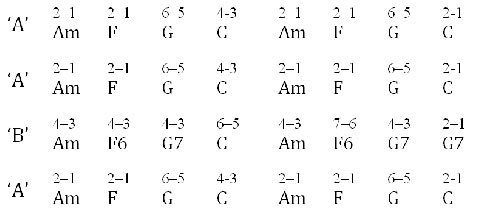Patreon CHORDS 101 Series
'Longing' - piano solo
(Suspensions, Page Four)
Suspensions are a great way to get more out of any chords you know. This page hosts the lesson material for two Musicarta piano solos which feature suspensions and 'accented non-chord tones' extensively.
The suspension riffs on these pages are 'generic' and demonstrate an aspect of music theory which is available to anyone. Any resemblance to any recorded music is entirely accidental.
Make sure you work through the pages in order. This is Page Four of the series - start with Page One.
Musicarta's home-study courses usually have a suspensions module where the suspensions-release technique is applied to the course chord sequence.
Here is the suspensions-release technique applied to the four essential chords covered in Musicarta Key Chords Volume 1, in a piece called 'Longing'.
The chord sequence
RAC NB Change this picture

Musical 'form'
Noticing the ‘form’ (structure) of music makes it easier to remember and puts you more in charge. Notice that the letters ‘A’ and ‘B’ have nothing to do with notes or chords. ‘AABA’ simply means:
- This piece is in four parts.
- The first, second and last parts are the same (or very similar), and
- The third part (‘the B strain’) is significantly different.
Notice that the parts of an AABA-form song are often called ‘strains’ – ‘the A strain’, ‘the B strain’, etc., particularly in jazz. The 32-bar AABA song form (which this Key Chords Diaries variation follows) is the form of the ‘jazz standard’ and thousands of other popular songs. It’s a form we instinctively find satisfying.
Recognising and describing suspensions
Suspensions are indicated with numbers ‘above the root’ (4–3, etc.). Therefore, you need to know which note the root is. The root is the name-note of the chord and therefore the letter in the chord symbol.
You can get somewhere just counting note-letter-names. E.g, for G7sus4 or G (4–3) you would want to count four notes up from G - with G as 1 – all the notes in an interval are counted):
G–A–B–C
C is the non-chord tone you play. It’s the third (B), suspended, and B is where it will fall back to.
But looking at written-out music, you want rather to be able to identify which note of a triad (as a shape) the root is.
In a triad, the root is
- the bottom note of a root position chord (circle symbol);
- the top note of a first inversion chord (triangle symbol); and
- the middle note of a second inversion chord (square symbol).
Learning methodically
It will pay you to learn the plain, underlying chords thoroughly before applying the suspensions. Here are the ‘A’ and ‘B’ strains, plain and with suspensions.
‘A’ strains (bars 1–8, 9–16 and 25–32) – Plain chords

(The audio files in this 'how-to' section play through the music twice, for practice purposes.)
‘A’ strains – Chords with suspensions

Learn the melody as a separate item. The melody notes are sometimes above, sometimes below and sometimes actually inside the supporting chord, so it's important that you know the tune so you can make it stand out.
‘B’ strain (bars 17–24) – Plain chords

Apart from the last chord and a tweak to the F, they're the same as the A strain chords. It's the suspensions that make it different.
The chords without the circle/square/triangle symbols are 'non-standard'. Look out also for root arrows pointing at empty spaces - where the root would be if it were being played.
‘B’ strain (bars 17–24) – Chords with suspensions

Only Am, F, G and C chords are used in this piece. In the Roman numeral chords-in-any-key system, these are vi, IV, V and I (in C). These four ‘key chords’ are the ones most likely to crop up in a pop song, and they’re also the four chords covered in the Musicarta Key Chords Volume 1 keyboard creativity home study digital download, now available at only $14.95 from musicarta dot com.
If you want to get your hands round chords, these are the ones you should start with. Read more in the following section.
Learning the left hand part
The left hand part has leaps between a bass note and the notes of a chord, itself broken. You will save yourself a lot of time and frustration if you:
- Squash the broken chord back into line and learn them that way; and
- Practice the left hand leaps with the unbroken chords first.
You can see the left hand material referred to in the bottom keyboard of this four-layer MidiPiano performance of the piece.
The top keyboard shows the RH chords without suspensions; the next one down shows the suspensions; the second keyboard up shows the actual performance.
Here is the MS of what and how to practice.
Left hand part – ‘A’ strain

The essential thing is to get your hand up from the bass note and over the chords quickly and accurately.
For the last four bars of the study, play the bass notes an octave lower than shown.
Left hand part - 'B' strain
Don’t be foxed by those low, low bass notes! Bass notes are always the note named in the chord symbol (A, E, G etc.) unless otherwise indicated – by a ‘slash chord’ symbol, for example.
Added chord tones
A figure following the letter in a chord symbol indicates that another note has been added to the three chord tones (root, third, fifth) usually used. The note is counted up from the root (name-note), ‘inclusively’ – that is, counting the name-note as ‘1’.
You count letter-names, but you must apply the key signature of the chord’s root, NOT of the key your playing in.
‘F6’ is relatively easy. You count F–G–A–B flat–C–D, so D is the added note, which is not affected by the F major key signature and so is still a white key. ‘F6’ will always have an added D natural, regardless of the key of the piece.
But if you saw, say, ‘A6’, you’d have to count up the A major scale: A–B–C sharp–D–E–F sharp, and the added note would be black-key F sharp.
[Don’t
know your scales so well? Link
through to the Musicarta Scales page.]
This rule applies to the numbering of suspensions, too. In bar 18, you see the chord symbol F (#4–3). Why the sharp in front of the 4? Because ‘4’, for the F chord, is the fourth note up of the F major scale (even though we’re in C), which would be a B flat. But a B natural is required, so we’ve had to ‘sharp’ (raise by a semi-tone) the 4 for accuracy.
The exception to this apply-the-key-signature rule is ‘7’, which does not indicate the seventh note of the major scale of the chord name-note, but the ‘dominant seventh’ – the flattened seventh, the note a whole tone below the chord root - a semitone again below the major seventh.
So the added note in G7 is F, not F sharp (the seventh note of the G major scale).
The added note in C7 is B flat, not B natural (the seventh note of the C major scale), and so on.
[Want
to know more about seventh chords? Link
through to the Musicarta Seventh Chords page.]
One last point. You don’t always see four different notes in an ‘added tone’ (F6, G7) chord. sometimes the added note is played instead of a regular chord tone to avoid harmonic ‘clutter’.
In this study. the left hand F6 and G7 chords are both three-note chords – the chord tone fifth has been dropped in both cases.
A different arrangement
You might not need or want to play a full piano solo version of this Musicarta chord study. With an electronic keyboard, for example, you can play a version with ‘pad’ chords in the left hand and a solo voice playing the sus-res tune.
Here’s a possible arrangement. (Warning: very un-cool synth sound approaching!)
Here's the A strain of that arrangement, played on the piano (where it's easier to hear the individual parts):
In the Musicarta suggestion, the right hand has gone up an octave. Because the left hand is now playing plain block chords, the right hand is filling in some of the quaver slots notes from the underlying ‘plain’ chords.
If you’re working this out yourself, your left hand chords will probably start on an A minor root-position chord and move smoothly and musically to nearest-inversion chords after that. Study the left hand part of the arrangement to see how.
Here’s a suggestion for the B strain.
The melody is in broken octaves, with chord tones between. Try to ‘get the general idea’ and run with it, not rely on the dots!
There's another Musicarta piano solo featuring suspensions and accented non-chord tones extensively. Click through to the 'Evening Song' piano solo page here.
Hope you're enjoying studying with Musicarta! Come back soon!
|
OUT NOW! |
THE MUSICARTA BEAT & RHYTHM WORKBOOK At last! An effective approach to keyboard rhythm & syncopation skills. Learn more! |
ONLY $24.95! |
PATREON |
The MusicartaA methodical approach to keyboard syncopation for
|
PUBLICATIONS
exciting keyboard
creativity courses
CHORDS 101
WORKBOOK

~HANON~
video course

Musicarta
Patreon
PENTATONICS
WORKBOOK
video course

Creative Keyboard
video course

BEAT AND RHYTHM
WORKBOOK

- Volume 1 -

12-BAR PIANO
STYLES WORKBOOK

MUSICARTA MODES
WORKBOOK

PIANO STYLE

CANON PROJECT
video course

VARIATIONS
video course


- Piano Solo -
video course

- Piano Solo -


YouTube playlists

